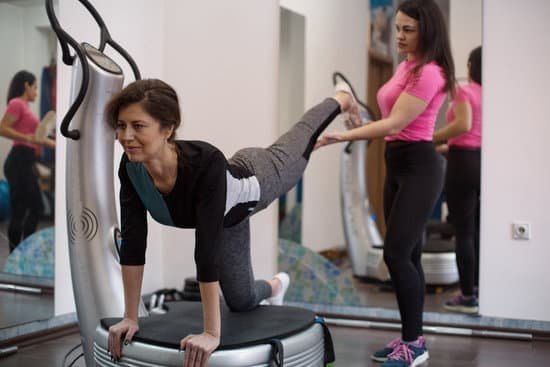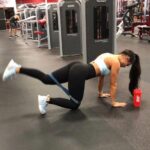Are you looking to improve your overall health and wellness? Look no further than an all around fitness routine. This comprehensive approach to physical fitness encompasses a variety of exercises and activities that can help you achieve your fitness goals, build strength, improve flexibility, and enhance your overall well-being.
When it comes to achieving optimal physical fitness, setting clear and achievable goals is essential. Whether you want to lose weight, build muscle, or simply improve your cardiovascular health, understanding what you want to achieve is the first step in creating an effective fitness routine.
In this article, we will explore the key components of an all around fitness routine, including cardio workouts, strength training, flexibility and mobility exercises, nutrition and diet tips, rest and recovery strategies, cross-training techniques, and how to track your progress. By embracing a holistic approach to fitness with an all around fitness routine, you can take control of your health and transform your body for the better.
Setting Fitness Goals
When starting an all around fitness routine, it’s important to first set clear and achievable fitness goals. Whether you want to lose weight, build muscle, increase endurance, or simply improve overall wellness, having specific goals will help guide your fitness journey and keep you motivated. Here are some tips on how to determine what you want to achieve with your fitness routine:
1. Identify Your Priorities: Take some time to reflect on what is most important to you when it comes to your fitness. Are you focusing on aesthetics, performance, or health? Understanding your priorities will help shape your goals.
2. Make Them Specific: Instead of setting vague goals like “get in shape” or “be healthier,” make them specific and measurable. For example, “lose 10 pounds in 3 months” or “complete a 5k run in under 30 minutes.”
3. Consider Your Timeline: Setting realistic timelines for your goals is essential for staying on track and monitoring progress. Be honest with yourself about how much time and effort you can realistically commit to reaching each goal.
By following these steps, you can effectively determine what you want to achieve with your all around fitness routine and set yourself up for success. Remember that everyone’s fitness journey is unique, so be sure to tailor your goals to fit your personal needs and abilities.
Cardio Workouts
When it comes to achieving overall fitness, incorporating cardio workouts into your fitness routine is crucial. Aerobic exercise not only helps in improving cardiovascular health but also supports weight loss, enhances endurance, and boosts mood. Here are some key reasons why cardio workouts should be an essential part of your all-around fitness routine:
1. Improved Heart Health: Regular aerobic exercise, such as running, swimming, or cycling, can strengthen the heart and improve its ability to pump blood more efficiently. This can lead to a reduced risk of heart disease and other cardiovascular conditions.
2. Weight Management: Engaging in cardio workouts can help burn calories and support weight loss efforts. A consistent aerobic exercise routine combined with a healthy diet can aid in shedding excess body fat and maintaining a healthy weight.
3. Enhanced Endurance: Cardiovascular workouts help build stamina and endurance over time. This means you’ll be able to perform daily activities with less fatigue and participate in physical activities for longer periods without feeling exhausted.
Whether it’s going for a run or joining a high-intensity interval training (HIIT) class, incorporating at least 150 minutes of moderate-intensity aerobic activity per week is recommended by health experts for overall health benefits. By including cardio workouts into your fitness routine, you’ll be able to attain a well-rounded approach to achieving your fitness goals.
Stay motivated and consistent in integrating these exercises into your routine to experience the full range of benefits they offer for overall health and wellness.
Strength Training
Benefits of Strength Training
Incorporating strength training into your all around fitness routine offers a wide range of benefits. Building lean muscle mass not only improves your physical appearance, but it also increases your metabolism, enhances bone density, and promotes better posture. Additionally, strength training can boost your overall strength and endurance, making everyday tasks easier to accomplish.
Types of Strength Training Exercises
There are various types of strength training exercises that can be included in an all around fitness routine. These include bodyweight exercises, such as squats and push-ups, as well as weight-bearing exercises using dumbbells, resistance bands, or weight machines. It’s important to focus on different muscle groups, including the legs, arms, back, chest, and core, to ensure a balanced approach to building lean muscle mass.
Frequency and Progression
To effectively build lean muscle mass through strength training, it’s important to establish a consistent workout schedule. Aim for at least 2-3 sessions per week, allowing for rest days in between to prevent overtraining. As you progress in your fitness journey, gradually increase the intensity of your workouts by adding more weight or increasing the number of repetitions. Tracking your progress and continually challenging yourself are essential for achieving optimal results in your all around fitness routine.
Flexibility and Mobility
Benefits of Flexibility Training
Flexibility training is an often overlooked but crucial aspect of any all around fitness routine. By improving the range of motion in your joints and muscles, flexibility exercises can help prevent injury, reduce muscle soreness, and improve overall athletic performance. Incorporating regular stretching exercises into your fitness routine not only increases flexibility but also enhances muscle coordination and balance.
Types of Flexibility Exercises
There are various types of flexibility exercises that can be incorporated into a well-rounded fitness routine. Static stretching involves holding a stretch position for a period of time, while dynamic stretching involves moving your body through a full range of motion in a controlled manner.
Yoga and Pilates are also excellent options for improving both flexibility and strength. By incorporating these different types of flexibility exercises into your workout regimen, you can achieve greater overall mobility and resilience in your body.
The Significance of Mobility
Mobility refers to the ability to move freely and easily throughout a specific range of motion. It is essential for performing everyday activities like bending down to pick something up or reaching overhead to grab an item from a shelf. In the context of an all around fitness routine, mobility exercises focus on enhancing functional movement patterns that are necessary for maintaining independence and preventing injury as we age.
Incorporating Mobility Workouts
In order to improve mobility, it’s important to include exercises that target specific movements required for daily activities. This may include hip openers, shoulder mobility exercises, or core-strengthening movements that support spinal stability. By adding mobility workouts to your fitness routine, you can enhance your overall physical function while reducing the risk of strains and sprains during exercise or daily activities.
By prioritizing flexibility and mobility in your all around fitness routine, you can greatly enhance your physical well-being and improve overall performance across various physical activities. Incorporating regular stretching and mobility workouts into your regimen not only reduces the risk of injury but also supports long-term musculoskeletal health. Remember that maintaining optimal flexibility and mobility is just as important as strength training and cardio when striving for comprehensive fitness results.
Nutrition and Diet
In order to achieve optimal results in your all around fitness routine, it is essential to pay close attention to your nutrition and diet. This aspect of fitness plays a crucial role in fueling your body for workouts, aiding in muscle recovery, and supporting overall health and wellness. Without proper nutrition, your fitness goals may be difficult to attain.
When it comes to nutrition for an all around fitness routine, it’s important to focus on consuming a balanced diet that includes a variety of nutrients. This means incorporating lean proteins, healthy fats, complex carbohydrates, and a plethora of fruits and vegetables into your meals. Hydration is also key-drinking an adequate amount of water throughout the day will help support your energy levels and overall performance during workouts.
In addition to fueling your body with the right foods and beverages, timing is also crucial when it comes to nutrition and exercise. Consuming a balance of macronutrients before and after workouts can aid in muscle repair and growth.
Post-workout meals should include protein and carbohydrates to replenish energy stores and support muscle recovery. By paying attention to your nutritional intake as part of your all around fitness routine, you’ll be better equipped to achieve the results you’re striving for.
Rest and Recovery
Overtraining can lead to fatigue, decreased performance, and an increased risk of injury. Incorporating regular rest days into your workout schedule can help prevent these negative effects. Rest days do not necessarily mean complete inactivity; low-impact activities such as walking, yoga, or light stretching can still be beneficial for promoting blood flow and aiding in recovery.
In addition to rest days, getting enough quality sleep is equally important for overall health and fitness. During sleep, the body produces growth hormone, which is essential for muscle repair and recovery. Lack of sleep has been linked to impaired athletic performance, decreased cognitive function, and an increased risk of weight gain. Aim for 7-9 hours of uninterrupted sleep each night to support your fitness goals.
| Importance | Examples |
|---|---|
| Allows Muscle Repair | Rest days promote muscle repair and growth |
| Prevents Overtraining | Rest days help prevent fatigue and injury from overtraining |
| Aids Recovery | Sleep aids in muscle recovery through the production of growth hormone |
Incorporating Cross-Training
Incorporating cross-training into your fitness routine is a crucial element in achieving overall fitness improvement. Cross-training involves participating in a variety of different types of exercise to enhance various aspects of physical fitness. By mixing up your workouts, you can prevent boredom, avoid overuse injuries, and improve your overall performance.
One of the main benefits of cross-training is that it allows you to work different muscle groups and cardiovascular systems, leading to a well-rounded improvement in all areas of fitness. For example, if you are primarily a runner, incorporating strength training and flexibility exercises into your routine can help improve your endurance, speed, and agility while also reducing the risk of injury.
When incorporating cross-training into your fitness routine, it’s important to choose activities that complement each other. For example, if you enjoy high-impact activities like running or aerobics, incorporating low-impact exercises like swimming or cycling can provide a much-needed break for your joints and muscles while still allowing you to maintain cardiovascular fitness.
Overall, incorporating cross-training into your all-around fitness routine can lead to improved strength, endurance, flexibility, and cardiovascular health. By diversifying your workouts and challenging your body in new ways, you can achieve a more balanced level of physical fitness and prevent plateaus in your progress. Remember that variety is key when it comes to achieving optimal results from your workouts.
Tracking Progress
As you embark on your all around fitness routine, tracking your progress is an essential part of achieving your goals. By using metrics and measurements to monitor your fitness journey, you can stay motivated, make necessary adjustments to your routine, and celebrate your achievements along the way.
One of the most common ways to track progress is by monitoring body measurements and weight. Keeping a record of your weight, body fat percentage, waist circumference, and other relevant measurements can provide insight into the changes happening in your body as a result of your fitness routine. Additionally, tracking your physical performance and endurance levels through metrics such as running times, lifting capacities, or flexibility tests can show improvements in strength, stamina, and flexibility over time.
Another valuable tool for tracking progress is journaling. Keeping a workout log that details the exercises you perform, the number of sets and repetitions completed, as well as any notes about how you feel during each workout can help identify patterns and areas for improvement within your routine.
Furthermore, leveraging technology such as fitness apps or wearable devices can provide accurate data on various aspects of your fitness journey. From heart rate monitoring during cardio sessions to sleep tracking for recovery, these tools offer valuable insights into how different facets of your lifestyle are impacting your overall health and fitness levels.
| Tracking Your Progress | Measuring Success |
|---|---|
| Monitoring body measurements and weight | Keeping a record of changes in the body |
| Journaling workouts | Identifying patterns and areas for improvement |
| Leveraging technology (fitness apps or wearable devices) | Obtaining accurate data on different facets of the fitness journey |
By being diligent with measuring and monitoring your progress throughout your all around fitness routine, you can gain a deeper understanding of how exercise, nutrition, rest, and recovery are impacting your overall health and wellness. This knowledge will empower you to make informed decisions that will continue propelling you towards success in meeting your fitness goals.
Conclusion
In conclusion, it is evident that embracing a holistic approach to fitness with an all-around fitness routine is the key to achieving optimal results. By incorporating cardio workouts, strength training, flexibility and mobility exercises, as well as focusing on nutrition, rest, and recovery, individuals can improve their overall health and wellness. This comprehensive approach not only helps in achieving physical fitness goals but also contributes to mental and emotional well-being.
Moreover, the incorporation of cross-training into a fitness routine is essential for preventing plateaus and continuously challenging the body. By mixing up workouts and engaging in different physical activities, individuals can avoid boredom and maintain motivation in their fitness journey. Additionally, tracking progress through metrics and measurements provides valuable feedback on the effectiveness of the fitness routine, allowing for necessary adjustments to be made.
Ultimately, by following an all-around fitness routine, individuals can experience improved strength, endurance, flexibility, and overall wellness. It is important to recognize that fitness is not just about appearance or physical performance but also about longevity and quality of life. Therefore, prioritizing a holistic approach to fitness will lead to long-term health benefits and an enhanced sense of well-being.
Frequently Asked Questions
What Is the Best Overall Workout Routine?
The best overall workout routine is one that combines cardiovascular exercises, strength training, and flexibility work. This can include activities like running, weightlifting, and yoga to provide a well-rounded approach to fitness.
What Is an All Round Fitness Regime?
An all-round fitness regime is one that addresses all aspects of physical health, including aerobic fitness, muscular strength and endurance, flexibility, and body composition. It should be balanced and adaptable to individual needs.
What Is a Good Routine to Get Fit?
A good routine to get fit should include a mix of cardiovascular exercises (such as running or cycling), strength training (like bodyweight exercises or weightlifting), and flexibility work (such as yoga or stretching). Consistency is key for improvement.

Passionate about providing useful information to anyone with an interest in the field of Personal Training, I strive to pass on to our readers quality information and to answer any questions about Personal Trainers, the work they do and how to become one.





